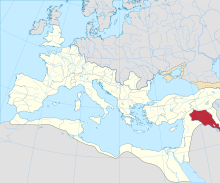Mesopotamia (Roman province)
| Provincia Mesopotamia ἐπαρχία Μεσοποταμίας | |||||||||
|---|---|---|---|---|---|---|---|---|---|
| Provinceof theRoman Empire | |||||||||
| 116–117 198–637 | |||||||||
 Provincia Mesopotamia within the Roman Empire. | |||||||||
| Capital | Amida(Diyarbakır) /Dara(Oğuz) /Nisibis(Nusaybin) | ||||||||
| Historical era | Antiquity | ||||||||
• Established byTrajan | 116 | ||||||||
• Evacuated byHadrian | 117 | ||||||||
• Re-established bySeptimius Severus | 198 | ||||||||
| 637 | |||||||||
| |||||||||
| Today part of | Iraq Turkey Syria | ||||||||


Mesopotamiawas the name of aRoman province,initially a short-lived creation of theRoman emperorTrajanin 116–117 and then re-established by EmperorSeptimius Severusin c. 198. Control of the province was subsequently fought over between the Roman and theSassanian empiresuntil theMuslim conquestsof the 7th century.
Trajan's province[edit]
In 113, the Roman emperorTrajan(r. 98–117)launched a waragainst Rome's long-time eastern rival, theParthian Empire.In 114, he conqueredArmenia,which was made into a province, and by the end of 115, he had conquered northernMesopotamia.This too was organized as a province in early 116, when coins were minted to celebrate the fact.[1]
Later in the same year, Trajan marched into central and southern Mesopotamia (enlarging and completing the province of Mesopotamia) and across the riverTigristoAdiabene,which he annexed into another Roman province,Assyria.[2]But he did not stop there. In the last months of 116, he captured the Persian city ofSusaand deposed the Parthian kingOsroes I,putting his own puppet rulerParthamaspateson the Parthian throne. Never again would the Roman Empire advance so far to the east.
As soon as Trajan died, however, his successorHadrian(r. 117–138) relinquished his conquests east of theEuphratesriver, which became again theRoman Empire's eastern boundary.[3][4]
Severus's province[edit]
Lucius Verus's campaign[edit]
Northern Mesopotamia, includingOsroene,came again under Roman control in theexpeditionofLucius Verusin 161–166, but were not formally organized into provinces; instead, they were left under local vassal rulers, although Roman garrisons were maintained, notably atNisibis.
Year of the Five Emperors[edit]
This control was threatened in 195, during the civil war betweenSeptimius Severus(r. 193–211) and the usurperPescennius Niger,when rebellions broke out in the area, and Nisibis was besieged. Severus quickly restored order and organized Osroene as a full province.[5][6]
Reconquest by Severus[edit]
Next, Severus embarked on a war against Parthia, which he concluded successfully with thesackof the Parthian capitalCtesiphon.In emulation of Trajan, he re-established a province of Mesopotamia in 198, with Nisibis, elevated to the status of a fullcolonia,as its capital.[7][8]
Unlike Trajan's province, which encompassed the whole of Roman-occupied Mesopotamia between the Euphrates and Tigris rivers, the new province was limited between the province ofOsroeneto the south, the Euphrates and Tigris to the north, and the river Chaboras (modernKhabur) to the east.[9]
Border conflict[edit]

For the remainder of its existence, the province would remain a bone of contention between the Romans and their eastern neighbors, suffering heavily in the recurrentRoman–Persian Wars.In the turmoil that followed theYear of the Six Emperors,in 239–243,Ardashir I(r. 224–241), the founder of the newSassanid Empirewhich replaced the moribund Parthians, attacked and overran the area, but it wasrecoveredbyTimesitheusbefore his death in 243.[10]In the 250s, the Persian shahShapur I(r. ca. 240–270) attacked Mesopotamia, and fought with the Roman emperorValerian(r. 253–260), whom hecapturedatEdessain 260.[11]In the next year, however,OdaenathusofPalmyratook a stand against Shapur, who eventually retreated.[12]
Diocletianic-Constantinian reorganization[edit]
Under the reforms ofDiocletian(r. 284–305) andConstantine I(r. 306–337), it became part of theDiocese of the East,which in turn was subordinated to thepraetorian prefecture of the East.

NisibisandSingara,along with the territory inAdiabeneconquered by Diocletian were lost after the debacle ofJulian'sPersian expeditionin 363, and the capital was transferred toAmida,while the seat of the military commander, thedux Mesopotamiae,was located atConstantina.Other cities includedMartyropolisandKephas.[9]
Late Roman/Early Byzantine Mesopotamia[edit]
After the troubles Roman forces faced in theAnastasian Warof 502–506, the East Roman emperorAnastasius I(r. 491–518) built the fortress ofDaraas a counter to Nisibis and as the new base of thedux Mesopotamiae.
During the reforms ofJustinian I(r. 527–565), the province was split up: the northern districts with Martyropolis went to the new province ofArmenia IV,while the remainder was divided into two civil and ecclesiastical districts, one (the region south of the Tigris) with capital at Amida and the other (the region ofTur Abdin) with capital at Dara.[9]The province suffered greatly during the near-constant wars with Persia in the 6th century. In 573, the Persians even took Dara, although the East Romans recovered it under the peace of 591. They lost it again to the Persians in thegreat war of 602–628,and regained it afterwards only to lose the entire region permanently to theMuslim conquestsin 633–640.[9]
See also[edit]
References[edit]
- ^Bennett (1997), pp. 196, 198–199
- ^Bennett (1997), p. 201
- ^Bennett (1997), pp. 206–207
- ^Mommsen, Dickson & Haverfield (2004), p. 72
- ^Mommsen, Dickson & Haverfield (2004), pp. 77–78
- ^Southern (2001), p. 33
- ^Mommsen, Dickson & Haverfield (2004), pp. 78–79
- ^Southern (2001), p. 42
- ^abcdKazhdan (1991), p. 1348
- ^Southern (2001), p. 70–71
- ^Mommsen, Dickson & Haverfield (2004), p. 100
- ^Mommsen, Dickson & Haverfield (2004), pp. 103–104
Sources[edit]
- Bennett, Julian (1997).Trajan: Optimus Princeps.Routledge.ISBN0-415-16524-5.
- Kazhdan, Alexander,ed. (1991).Oxford Dictionary of Byzantium.Oxford University Press.ISBN978-0-19-504652-6.
- Mommsen, Theodor; Dickson, William Purdie; Haverfield, Francis (2004).The provinces of the Roman Empire: from Caesar to Diocletian, Vol. II.Gorgias Press LLC.ISBN978-1-59333-026-2.[dead link]
- Southern, Pat (2001).The Roman Empire from Severus to Constantine.Routledge.ISBN978-0-203-45159-5.
- States and territories established in the 110s
- States and territories disestablished in the 7th century
- States and territories disestablished in the 2nd century
- Provinces of the Byzantine Empire
- Mesopotamia (Roman province)
- Late Roman provinces
- Near East in classical antiquity
- Ancient Upper Mesopotamia
- Iraq in the Roman era



